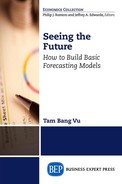Preface
This textbook is written for business persons who desire to forecast consumer demands and sales. It is also written for economic, financial, governmental, and private practitioners who want to make informed decisions based on costs, benefits, economic trends, and growth. Additionally, any researcher who wishes to predict a future event will benefit from this book. Finally, the book is written for upper-division undergraduate students, first year MBA or MA students, and other readers who wish to acquire a fundamental knowledge of quantitative forecasting for the purpose of pursuing jobs related to data analyses or making personal plans for the future.
Fictional Characters in This Book
Quantitative topics are often very abstract, and students sometimes lose focus on the subjects. To enhance your learning experience, a team of characters is introduced in this textbook. These characters are global citizens who will share their working and learning experiences with you throughout the book. By observing the applications of theoretical concepts into the business lives of these characters, you will learn the practical aspects of forecasting. Now, let me introduce our professors and classmates to you.
Professors
Dr. App is from Africa. She is an applied researcher and will teach applied forecasting in this course. Dr. Theo is from South America. He is a basic researcher and will be responsible for explaining any theoretical concept in this course.
Students
i.Ex and I are from Asia. Ex works for an import–export company called Excellency. My name is Na, and I am the owner of a nail salon called Nailight in this city.
ii.Alte and Rea are from the Pacific Islands. Alte runs an alteration service called Alcorner, and Rea works as a real-estate agent for a company called Realmart.
iii.Arti and Fligh are from North America. Arti is the director of an arts school called Artistown, and Fligh works for an airline company called Flightime.
iv.Sol and Mo are from Europe. Sol works for a solar energy company called Solarists, and Mo currently works for a motorcycle dealer called Motorland.
v.Fin is from Africa and works as an independent financial advisor.
vi.Cita is from South America and works for the city government.
The 10 of us are attending a forecasting class to either manage our businesses more efficiently or help our family and friends do so. We will join you in making the quantitative topics in this course more enjoyable to learn.
A Practical Approach
This book emphasizes the applied aspects of forecasting, so the only prerequisites for the course are high-school statistics and college algebra. The book discusses most of the forecasting methods frequently used in practice. All in-book analyses are accompanied by numerical examples that can be easily performed on a handheld calculator or Microsoft Excel, which is the only technical software required for all demonstrations and exercises in the book.
Two Excel folders are provided without charge on the BEP website. The first folder, Excel Demos, contains all Excel files that accompany the Excel demonstrations in this book, including the data and commands corresponding to the Excel applications in the text. Data in this folder are organized into chapters, and each of them is titled corresponding to the chapter number, for example, the file Ch01.xls consists of all data and commands for Chapter 1, with Sheet 1 for Figure 1.1 in the text, Sheet 2 for Figure 1.2 in the text, and so on. The second folder, Exercise Data, consists of all data for the exercises in the text. The data in this second folder are not accompanied by Excel commands so that you can become an active participant in the process of writing your own commands.
Topics in This Textbook
This book discusses most of the forecasting methods frequently used in practice, such as time series analyses, demand and sales, investment, short-term planning, long-term growth, and regression analyses. As the regression-based forecasts in this book are designed to be self-explanatory, knowledge of econometrics or time series modeling is not a prerequisite although it might be helpful. To keep the book concise, only a brief introduction to the autoregressive integrated moving average (ARIMA) models and the Box–Jenkins procedure is provided. Readers who wish to gain in-depth knowledge of ARIMA models are encouraged to read a book written specifically for time series modeling.
A folder including all solutions to the exercises is available to instructors once a book order is placed.
